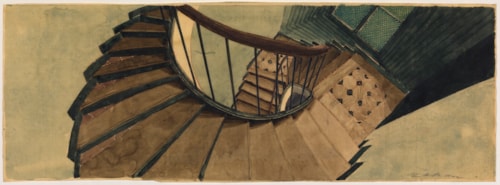
Sam SZAFRAN
Paris 1934 - Paris 2019
Biography
Born Samuel Berger in 1934 to Polish Jewish immigrants and raised in the area of Les Halles in Paris, Sam Szafran was imprisoned as a child at the Drancy internment camp, northeast of the city, during the Occupation. Following the Liberation he lived for some years with his mother and sister in Australia before returning to Paris in 1951, at the age of seventeen. He attended evening drawing classes and became friendly with a number of artists, including Jean Arp, Henri Cartier-Bresson, Yves Klein, Joan Miro and Jean-Paul Riopelle, as well as Alberto Giacometti. Although he was briefly enrolled at the Académie de la Grande-Chaumière in Paris in the mid-1950s, Szafran was largely self-taught as an artist. He took the maiden name of his mother when he began to sign his works, and exhibited at the Salon des Indépendants in 1957 and the Salon des Réalités Nouvelles two years later. While his earliest works were based in abstraction, from around 1960 onwards he began to depict representational subjects, drawn in pastel or charcoal and, from the late 1970s onwards, watercolour. Content with studying a limited range of themes - notably studio interiors, staircases and plant forms - he produced numerous drawings, each characterized by a very skillful handling of the medium and an abiding interest in perspectival effects. From 1965, when Szafran had his first solo exhibition, his work was exhibited extensively in France, and also in Switzerland, but only rarely elsewhere. Szafran contributed to the Nouvelle Subjectivité exhibitions curated by Jean Clair in Paris in 1976 and in Brussels in 1979. Throughout much of the artist’s career, his work was acquired by a coterie of enthusiastic and devoted collectors.
A retrospective exhibition of drawings, pastels, watercolours and sculptures by Szafran was held at the Fondation Pierre Gianadda in Martigny and the Fondation Maeght in Saint-Paul de Vence in 1999-2000. Later exhibitions followed at the Max Ernst Museum in Brühl in 2010-2011 and at the Fondation Gianadda in 2013. Following Szafran’s death in 2019, a large commemorative exhibition at the Musée de l’Orangerie in Paris in 2022-2023 drew some 330,000 visitors. In 2015 a permanent gallery devoted to Szafran’s work was established at the Fondation Gianadda in Martigny in Switzerland, while other works by the artist are today in the collections of the Metropolitan Museum of Art and the Museum of Modern Art in New York, the Centre National d’Art Contemporain, the Musée d’Orsay and the Musée d’Art Moderne in Paris, the Hirshhorn Museum and Sculpture Garden in Washington, D.C., the Musée Cantini in Marseille, and elsewhere.






